
A bumblebee is any of over 250 species in the genus Bombus, part of Apidae, one of the bee families. This genus is the only extant group in the tribe Bombini, though a few extinct related genera are known from fossils. They are found primarily in higher altitudes or latitudes in the Northern Hemisphere, although they are also found in South America, where a few lowland tropical species have been identified. European bumblebees have also been introduced to New Zealand and Tasmania. Female bumblebees can sting repeatedly, but generally ignore humans and other animals.

Buzz pollination or sonication is a technique used by some bees, such as solitary bees, to release pollen which is more or less firmly held by the anthers. The anthers of buzz-pollinated plant species are typically tubular, with an opening at only one end, and the pollen inside is smooth-grained and firmly attached. With self-fertile plants such as tomatoes, wind may be sufficient to shake loose the pollen through pores in the anther and accomplish pollination. Visits by bees may also shake loose some pollen, but more efficient pollination of those plants is accomplished by a few insect species who specialize in sonication or buzz pollination.

Trifolium pratense, red clover, is a herbaceous species of flowering plant in the bean family Fabaceae, native to Europe, Western Asia, and northwest Africa, but planted and naturalized in many other regions.

Bombus melanopygus, the black-tailed bumble bee, black tail bumble bee or orange-rumped bumblebee, is a species of bumblebee native to western North America.
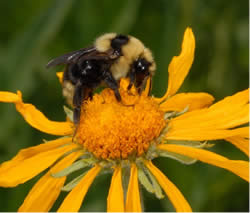
Bombus insularis is a species of bumblebee in the subgenus Psithyrus, the cuckoo bumblebees. It is native to northern and western North America, where it occurs throughout Canada, Alaska, the northern United States, and some western states. It is known commonly as the indiscriminate cuckoo bumblebee.

Bombus hortorum, the garden bumblebee or small garden bumblebee, is a species of bumblebee found in most of Europe north to 70°N, as well as parts of Asia and New Zealand. It is distinguished from most other bumblebees by its long tongue used for feeding on pollen in deep-flowered plants. Accordingly, this bumblebee mainly visits flowers with deep corollae, such as deadnettles, ground ivy, vetches, clovers, comfrey, foxglove, and thistles. They have a good visual memory, which aids them in navigating the territory close to their habitat and seeking out food sources.

Bombus suckleyi is a species of bumblebee known commonly as Suckley's cuckoo bumblebee, named after biologist George Suckley. Suckley's bumble bee is a generalist pollinator and represents a rare group of obligate, parasitic bumble bees. Suckley's bumble bee is a social-parasite because it invades the nests of the host bumble bees, including the western bumble bee, and relies on host species workers to provision its larvae. It is native to northwestern North America, including Alaska and parts of western and central Canada and the western United States.

Bombus pensylvanicus, the American bumblebee, is a threatened species of bumblebee native to North America. It occurs in eastern Canada, throughout much of the Eastern United States, and much of Mexico.

Bombus occidentalis, the western bumblebee, is one of around 30 bumblebee species present in the western United States and western Canada. A recent review of all of its close relatives worldwide appears to have confirmed its status as a separate species.

Bombus ruderatus, the large garden bumblebee or ruderal bumblebee, is a species of long-tongued bumblebee found in Europe and in some parts of northern Africa. This species is the largest bumblebee in Britain and it uses its long face and tongue to pollinate hard-to-reach tubed flowers. Bumblebees are key pollinators in many agricultural ecosystems, which has led to B. ruderatus and other bumblebees being commercially bred and introduced into non-native countries, specifically New Zealand and Chile. Since its introduction in Chile, B. ruderatus has spread into Argentina as well. Population numbers have been declining and it has been placed on the Biodiversity Action Plan to help counteract these declines.

Bombus mixtus is a species of bumblebee. It is native to western North America, where it occurs in western Canada and the United States. It is also disjunct in the Great Lakes region. It is known commonly as the fuzzy-horned bumblebee, tricoloured bumblebee, orange-belted bumblebee, and mixed bumblebee.
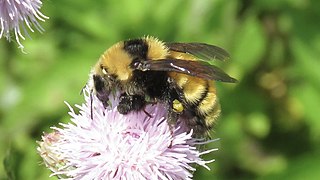
Bombus borealis is a species of bumblebee known commonly as the northern amber bumblebee. It is native to northern North America, where it occurs across Canada and Alaska and the northern and eastern contiguous United States.

Bombus crotchii, commonly called Crotch's bumblebee, is a species of bumblebee named after the entomologist George Robert Crotch. It is classified as endangered due to the impacts of pesticides, climate change, and human development.

Bombus griseocollis is a species of bumblebee known commonly as the brown-belted bumblebee. It is native to much of the United States except for the Southwest, and to the southernmost regions of several of the provinces of Canada.
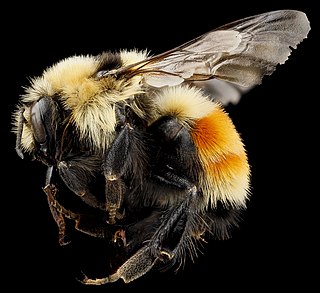
Bombus huntii is a species of bumblebee. It is native to western North America, where it occurs in western Canada and the United States as far east as Manitoba and Minnesota, and in Mexico as far south as the Trans-Mexican Volcanic Belt. It is known commonly as the Hunt bumblebee or Hunt's bumblebee.
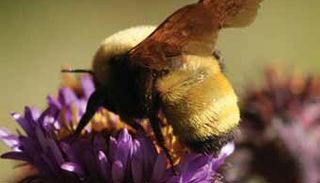
Bombus morrisoni is a species of bumblebee. It is native to western North America, including the western United States and British Columbia. It is known commonly as the Morrison bumblebee.
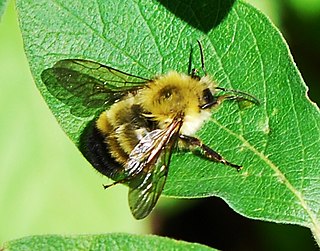
Bombus perplexus is a species of bumblebee known by the common name confusing bumblebee. It is native to northern North America, where it occurs across Canada and into the eastern United States.
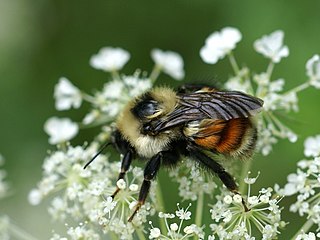
Bombus rufocinctus is a species of bumblebee known commonly as the "red-belted bumblebee." It is native to North America where it has a wide distribution across Canada and the western, midwestern, and northeastern United States. It may occur in Mexico.

Bombus sandersoni is a species of bumblebee known commonly as the Sanderson bumblebee. It is native to North America, where it occurs across Canada and in the eastern United States.

Bombus sylvicola is a species of bumblebee native to North America. It occurs throughout most of Canada, its distribution extending into Alaska and the western contiguous United States. In the southernmost extent of its range in California it occurs only at elevation. It is known commonly as the forest bumblebee.





















